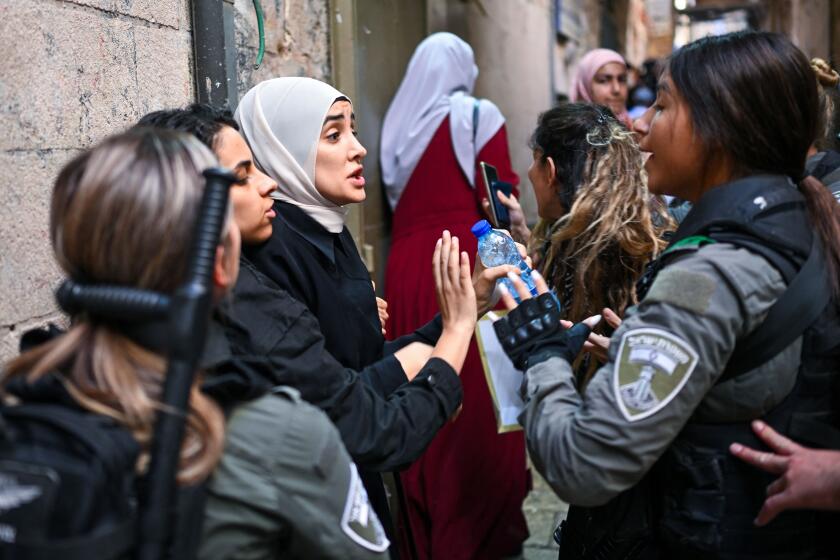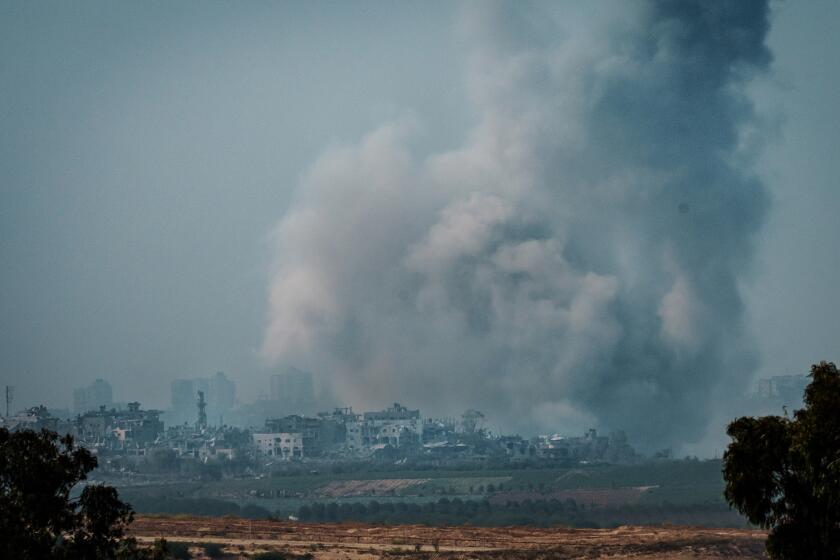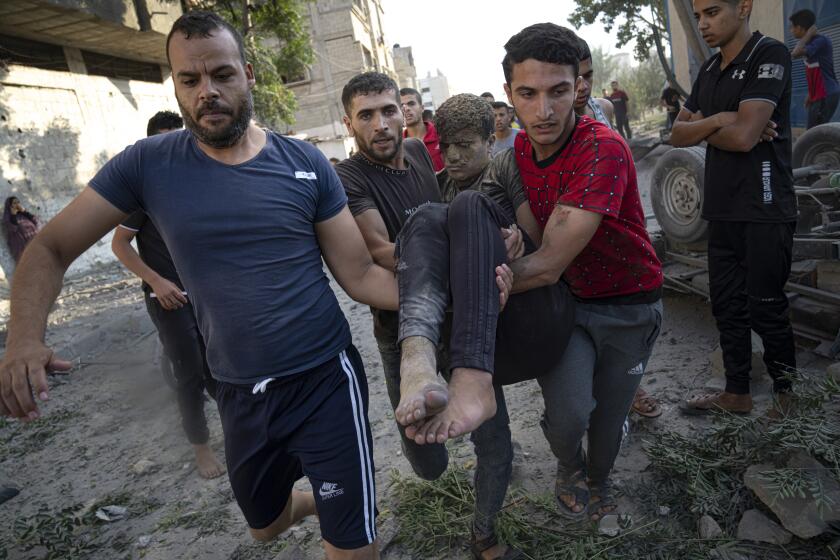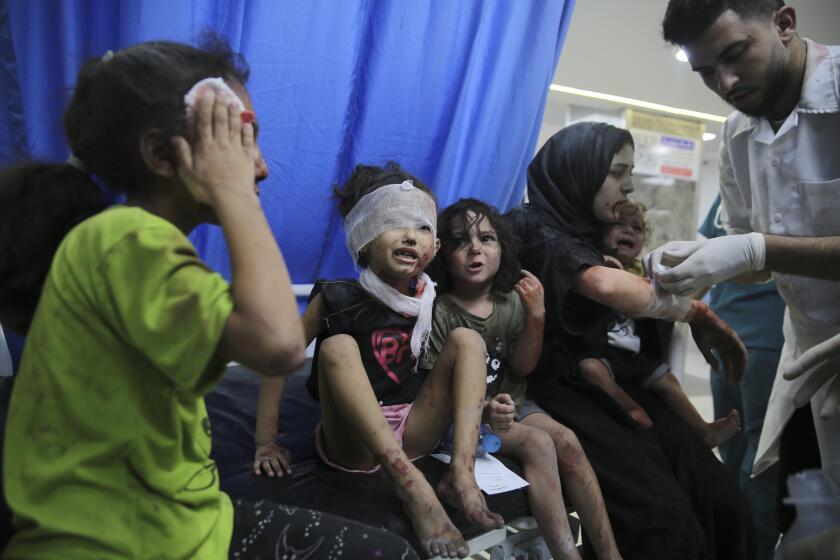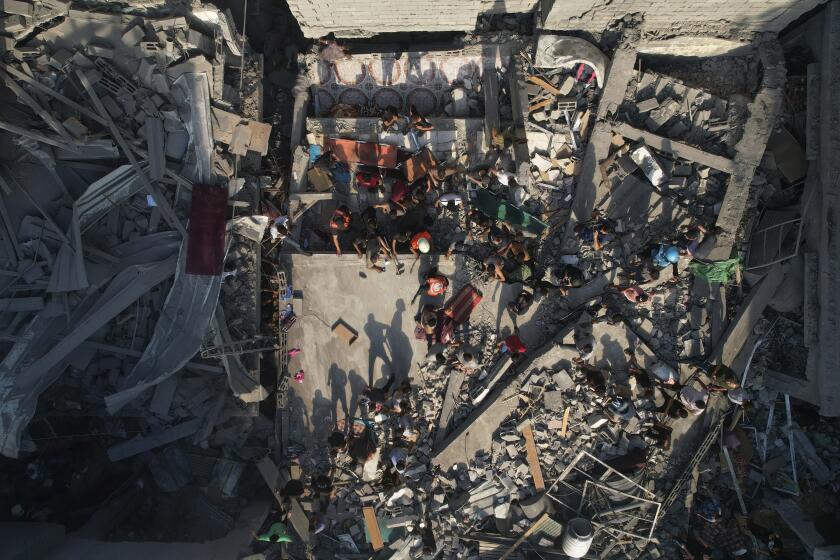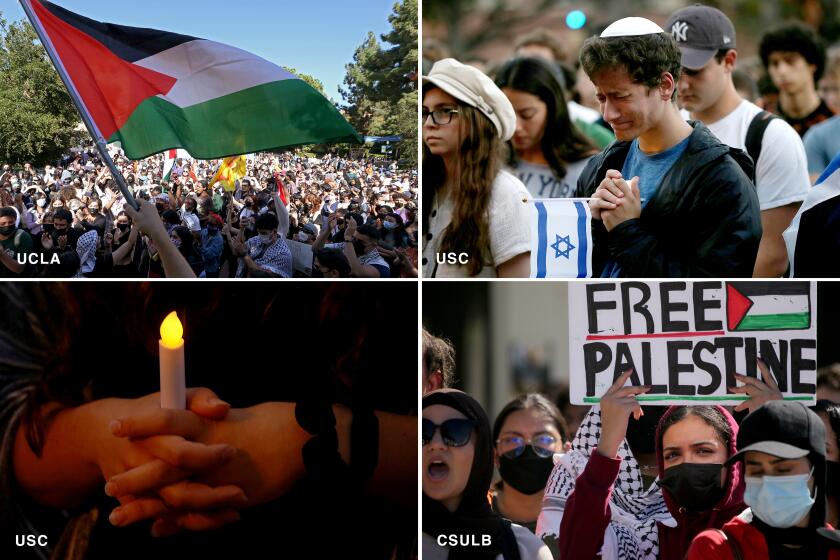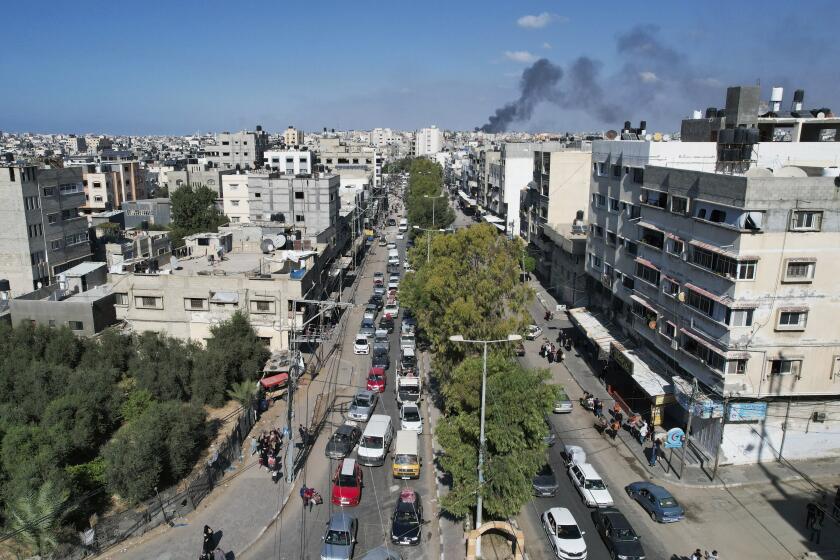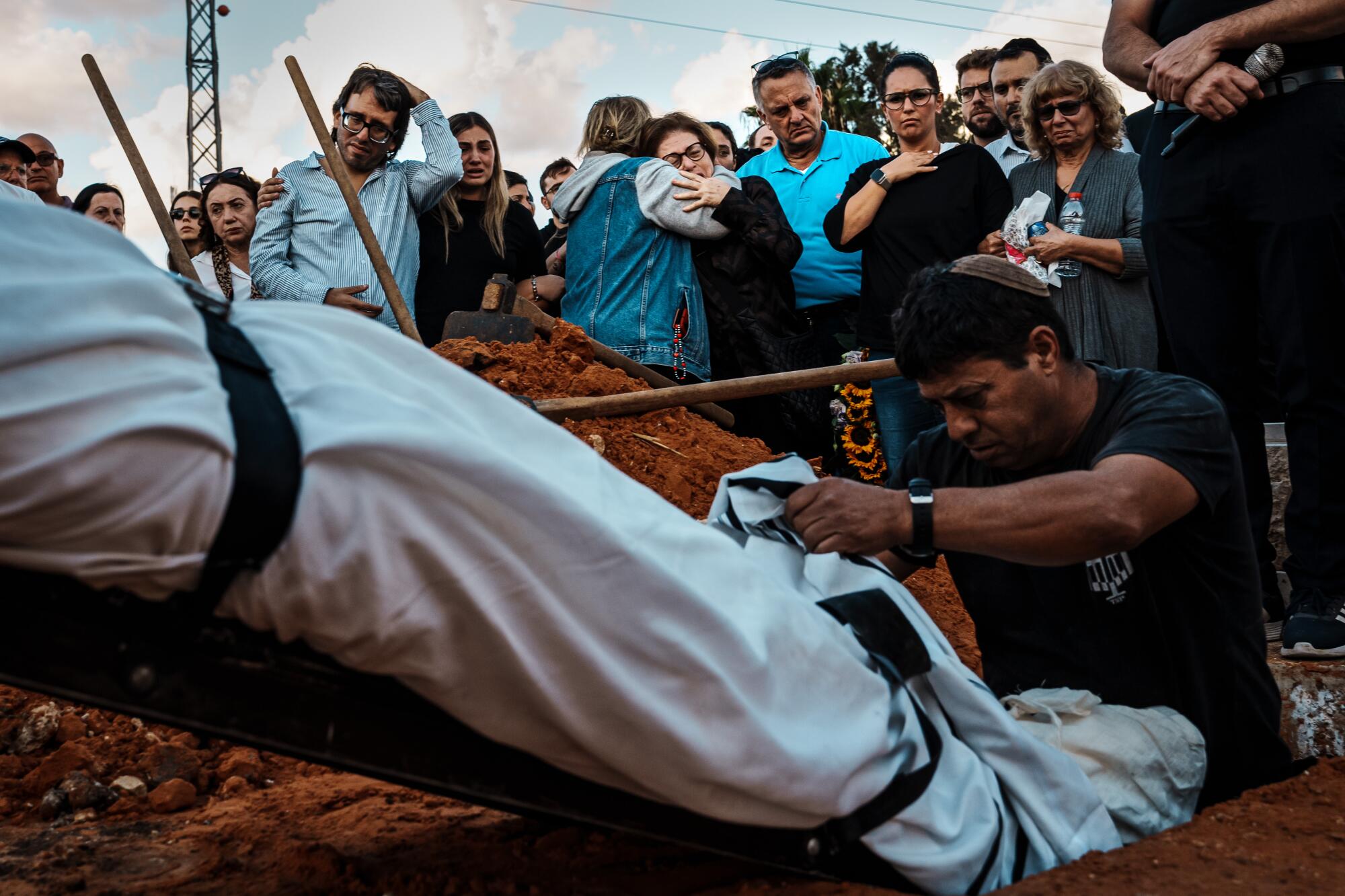
- Share via
JERUSALEM — Lamentations rise into balmy air, weeping mourners embrace, and shovels bite the sandy earth. Across Israel and inside the Gaza Strip, the sheer scale of deaths, the numbing numbers of fatalities, are overwhelming the living.
Mothers and babies, the young and the elderly, the robust and infirm, entire families together — all told, more than 4,200 lives, including those of hundreds of children, have been snuffed out in a wrenching spasm of violence that began in the early hours of Oct. 7, when Hamas militants breached Israel’s frontier with the Gaza Strip.
Almost no family, either Israeli or Palestinian, has been left untouched by this war, the deadliest between Israel and an Arab foe in half a century. Each death is a daub of paint on a vast canvas, but for the bereaved, each opens up a gaping chasm of grief.
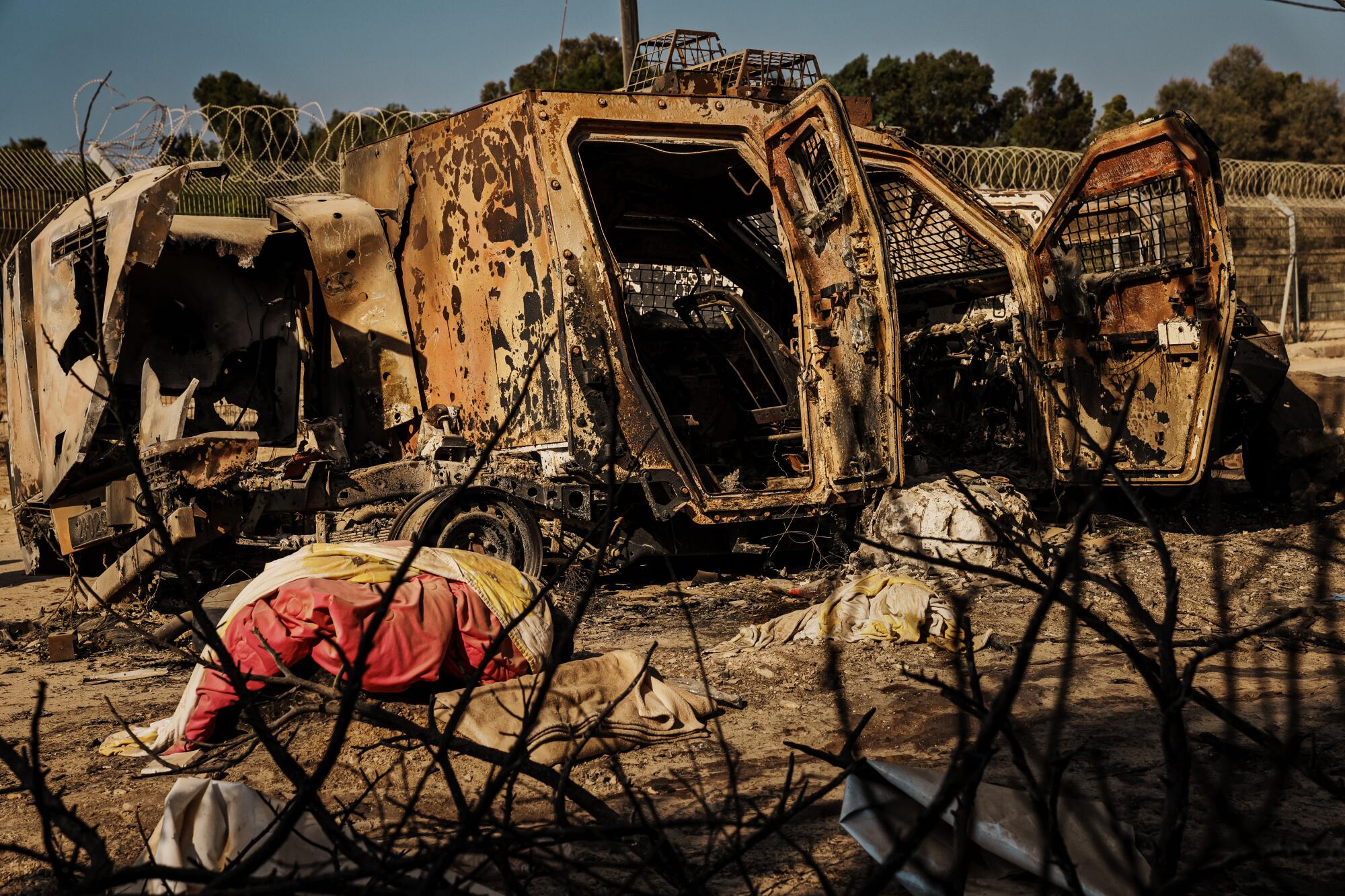
“I don’t say this out loud, but I need to ask God why — why was this good man murdered?” said Michael Levy, whose brother Daniel, a 34-year-old Peruvian-born physician and father of two, was killed in his kibbutz just outside Gaza as he tried to tend to the injured around him.
The hours-long Hamas attack, which left about 1,200 people dead in a string of small Israeli towns, farming communities and at an open-air desert music festival, marked Israel’s greatest one-day loss of life since the advent of statehood. More than a thousand of the dead were civilians. The Israeli government says 199 captives were spirited across the border into Gaza as hostages.
In the intervening days and nights, Israeli airstrikes of an intensity unprecedented in decades of conflict have reduced entire swaths of Gaza to ruins. Palestinian officials say some 2,800 people have been killed amid an exodus of near-biblical proportions set off by people trying to flee the bombardment.
Among them was Salam Mema, a 33-year-old Palestinian mother of three. She, her husband and two of their children died in the wreckage of their apartment, with only 7-year-old Ali left alive.
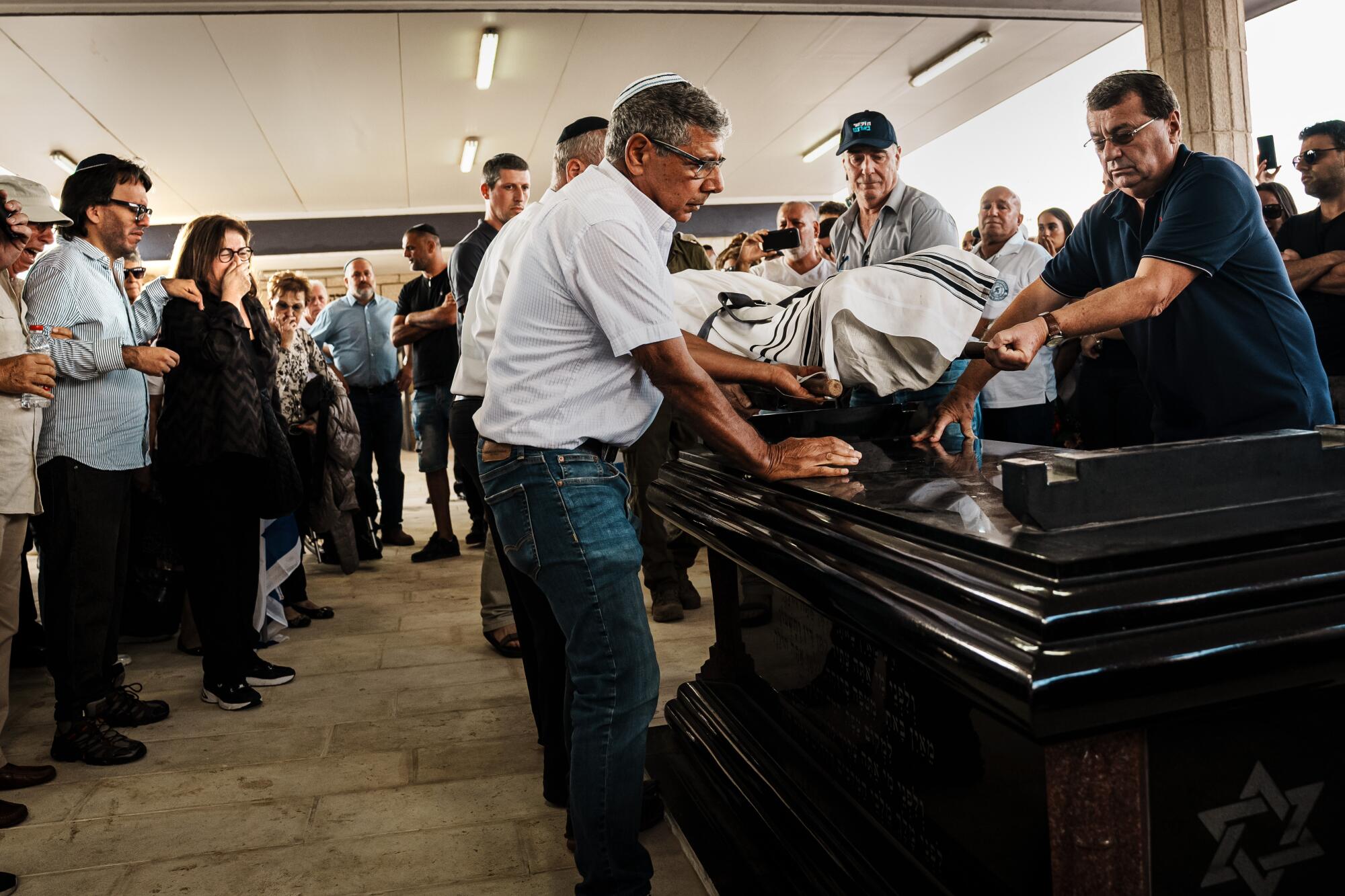
“They found hammers to smash the rocks and tried to dig her out with their hands,” recounted Mema’s mother, the children’s grandmother, who gave her name only as Umm Ibrahim. “But when they got her out, she was dead.”
As the Jewish Sabbath fell and Muslims marked their principal prayer day, Israelis and Palestinians struggled with the terrifying new reality after the militant group Hamas’ deadly attack on Israel.
The toll is certain to grow heavier, as Israel readies a ground invasion of Gaza whose aim it describes as the utter destruction of Hamas. Longtime observers warn that an extended bout of urban combat in the densely populated enclave, home to more than 2 million people, will almost certainly bring a staggering new round of fatalities.
In the meantime, day after day, amid the twitter of birdsong, the wail of air alerts or the roar of explosions, the dead are laid to rest.
“We move through these nights and days like sleepwalkers,” the eminent Israeli novelist David Grossman, who lost his son in a previous war, wrote in a column for Britain’s Financial Times.
“Who will we be,” he asked, “when we rise from the ashes and re-enter our lives?”
::
The Israeli military said in a statement on Saturday night that it was preparing a coordinated offensive in Gaza using air, ground and naval forces.
In communal villages, or kibbutzim, on the Israeli side of the Gaza border fence, daily life has long had aspects of both the suburban and the pastoral. Homes, some original structures dating back to the early days of statehood, were mainly built to be small and simple, with lush gardens and winding paths to shared amenities like swimming pools and community centers.
Every home had a mamad, or safe room, a reinforced shelter to which families could rush during the short seconds of warning after rockets were lobbed by Palestinian militants on the other side of the fence. That is where many residents took refuge on that Saturday morning when it became clear that their communities were under attack.
Hundreds of Palestinian Americans are reportedly stranded in Gaza, frantically searching for ways to flee before Israel’s expected ground assault.
But the shelters were designed to protect against flying debris and explosions, not as fortification against heavily armed assailants who were breaking in. In scores of homes, the safe rooms were where entire families were found dead.

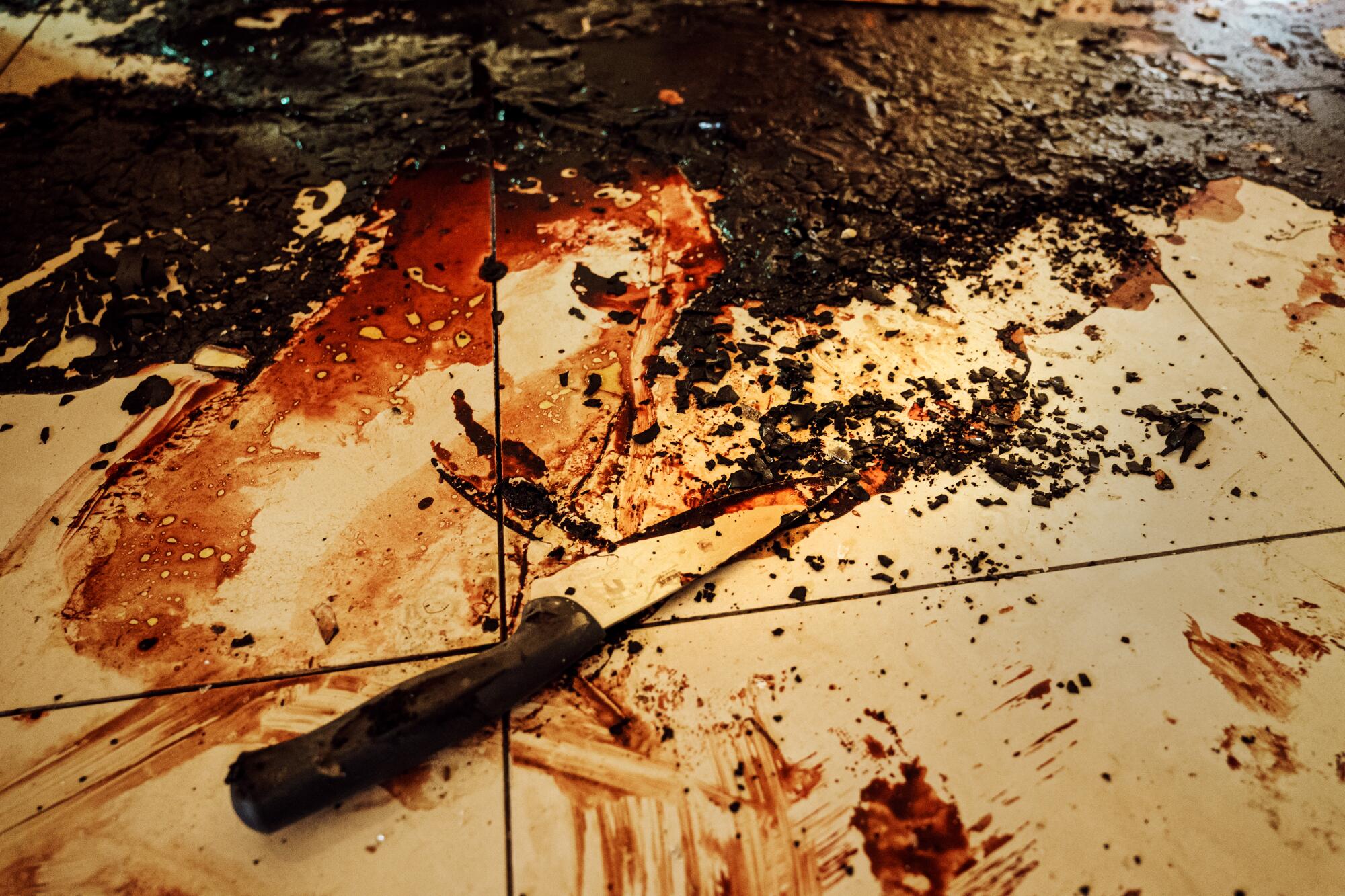
Even now, more than a week after the attack, Israeli rescuers are still discovering and recovering bodies, many of them burned, riddled with multiple gunshots, and mutilated to the point of unrecognizability.
“The ones we are gathering up now are the last few, the ones who tried so hard to hide themselves,” said Moshe Minaker, a volunteer with the Israeli group Zaka, a countrywide community emergency-response team working in concert with the army, going house to house through devastated villages.
“We find the ones the army missed at first — for example we discovered someone who was under a dresser, behind a bed, but the terrorists found him and shot him,” said Minaker, a 35-year-old father of two originally from Boston. He works in technology — thrust, like so many here, from workaday lives into the disorienting role of front-line worker.
In recent days, relatives’ torment has been compounded as grisly videos of the onslaught have emerged, some taken clandestinely by residents or kibbutz security cameras. But among the most horrific scenes were captured by the assailants themselves with mounted helmet or body cameras, some of the footage released by Israeli authorities.
The Israeli military has been taking journalists, including from the Los Angeles Times, into targeted communities including Kfar Azza — a kibbutz where about 800 people once lived, and at least 52 are known to have died — in order to view recovery efforts.
The suffocating scent of death hung in the air as broken glass crunched underfoot, and children’s toys, energy drinks, musical instruments and broken crockery were strewn about in shattered homes.
Ashen military officers likened the scenes to pogroms that haunt the ancestral memories of many Israelis. Even the volunteers of Zaka — whose ranks of religiously observant Jewish volunteers were known in the 1990s for gathering the tiniest scraps of flesh after suicide bombings in buses and cafes in order to provide victims with a proper religious burial — found what they saw unfathomable.
Yossi Landau, 55, who has volunteered with the group for more than three decades, said the sight of the mangled bodies he helped recover in Kfar Azza — infants, children, pregnant women, the elderly — was worse than anything he had ever encountered.
“I thought I could handle anything, but this is a level I can’t …” he said afterward in a phone interview, trailing off. “I’ve never seen this, and I hope I never will again.”
::

Across the border in Gaza, corpses are piling up everywhere, because ceaseless bombardment, a prelude to a likely Israeli ground invasion, has made it too dangerous to hold funerals.
Among all of the coastal enclave’s critical shortages — food and fuel, medicine and shelter, clean drinking water — another insufficiency emerged: Gaza, the United Nations said Monday, has run out of body bags.
Gaza’s residents are running low on food and water; its hospitals are struggling. President Biden to visit Israel as the U.S. is evacuating citizens.
Funerals in Gaza are usually daylong affairs, with public street processions and big gatherings under mourning tents.
That’s impossible now.
“People are too afraid to bury their dead because of the bombings, so the morgues are full of bodies,” said Ghassan Abu Sita, a surgeon at Shifa Hospital, Gaza City’s largest medical complex.
Driving home for a quick break from his nonstop duties, he passed by the morgue of another medical facility, just outside the Jabaliya refugee camp.

“There were piles of shrouded corpses put outside,” Abu Sita said. “Literally piled up.”
At one hospital, the situation was so dire that authorities have resorted to storing bodies in ice-cream trucks.
A medic at Aqsa Martyrs Hospital in central Gaza gestured toward a bright-blue refrigerated truck, normally used to convey sweet treats.
Medics in Gaza are warning that thousands could die as hospitals run desperately low on basic supplies and Israel’s ground offensive looms.
“The fridges are old and couldn’t handle the numbers, so we brought these,” he said.
But electricity is in extremely short supply, with power to the enclave having been cut off by Israel. Daytime temperatures are still warm. So another last resort is being employed: mass graves.
Palestinian Health Ministry spokesman Ashraf Qudrah said areas for the gravesites had been designated, and bodies were being transferred there. Arab-language television networks on Monday showed the first of such burials taking place.
Establishing identities was a difficult task, Qudrah said, because some whole families had died together, and many people were on the move after Israel last week ordered roughly half of Gaza’s population to move south for safety.
Before bodies were interred, Qudrah said, the ministry would collect forensic samples so families can track them later and rebury them properly.
Palestinian Americans with Gaza connections struggle with feelings of helplessness over violence after Hamas’ attack and Israel’s retaliation.
“When the war is over,” he said.
With conditions increasingly desperate in Gaza hospitals, medics described a harrowing struggle to treat the grievously injured, let alone maintain the dignity of the dead.
On Friday, an explosion whose circumstances remain disputed killed more than 70 people fleeing south on a main roadway in Gaza City. Hamas and rights groups blamed Israeli airstrikes, which Israel’s military denied.
“They were a pile of body parts,” a tearful emergency medic said in a video taken at Shifa Hospital. “We couldn’t take the body parts.”
Amid what can seem like all-encompassing death there is new life, often born in tragedy.
A pregnant woman named Lana Haddad was injured in a bombing that hit her three-story apartment building and killed her 4-year-old son and 16 members of her extended family, said the woman’s mother, who gave her name as Umm Ahmed.
Haddad, 28, who suffered a hip fracture and other injuries, was due to give birth at the end of the month. Doctors at Shifa Hospital performed an emergency caesarean section, and the baby survived.
“She’s a little girl,” Umm Ahmed said softly.
::
That four-fifths of the dead from inside Israel’s borders have been civilians is a shocking reversal for a country whose wartime deaths have always been primarily soldiers. The identification of bodies poses an enormous challenge, both logistically and psychologically.

An army base in Ramla, in the center of the country near Ben Gurion International Airport, is in normal times the headquarters of the military rabbinate. Now it has been pressed into service as a giant mortuary, an initial port of call for more than 1,300 bodies brought directly from the scene of the initial attack.
So pressing is the need for processing of the arriving remains that religious authorities granted dispensation for round-the-clock work to take place every day, including on the Jewish Sabbath, the religiously mandated day of rest.
Normally, that exemption is intended to apply only to lifesaving measures. In this instance, it was decided that the burden on families of not knowing the definitive truth about a loved one’s fate could constitute a threat to life — a dispensation not employed en masse for nearly 30 years.
“I can’t speak — my sister’s body has just been identified, and we have to plan the funeral,” Bar Yuval-Shani, whose sister and brother-in-law were killed while shielding their son in the safe room of their kibbutz home, said in a tear-choked message on Monday, more than a week after the assault.
At nearly midnight on a recent night, glaring floodlights illuminated a bleak scene: scores of masked workers in white protective suits and booties, long lines of white refrigerated containers, each holding up to dozens of bodies, stacked on racks in black or white bags.
College campuses are supposed to be bastions of intellectual discourse and debate, but the war in Gaza underscores tense narratives and little if any interchange between students.
Early on, workers spread sand to soak up pools of blood leaking as transport arrived. The smell of decomposition hung so heavily over the base that a bearded volunteer, eyes bleary but kind, offered eucalyptus oil to sprinkle inside masks.
The facility’s staff includes military reservists and career army officers who rushed to rejoin the ranks in this emergency; a former chief military rabbi, Israel Weiss, 74, came out of retirement to preside over the sorrowful task.
The DNA of Israeli soldiers is in a database, so nearly all of their bodies — almost 300 in all — have already been formally identified. For civilians, the wait may be much longer.
The Israeli reservists on duty at the mortuary base included a 40-year-old dentist, who under military rules could be identified only as Capt. Maayan. She described opening a body bag to see the face of a former patient, unscathed, although his body had been mutilated.
“No one should have to see what we see here,” she said, beginning to weep, “and what we will never stop seeing.”
Despite the likelihood that an Israeli invasion of Gaza could claim thousands of lives, some U.S. officials say Israel’s desire for revenge over Hamas attacks is justified.
Sophisticated testing takes place at the national forensics lab in Tel Aviv, where pathologists discovered that a blackened, carbonized lump of remains was that of a woman, clutching a child to her chest.
At Jerusalem’s Mt. Herzl, the resting place of national luminaries and fallen soldiers, the crush of burials in the first days after the Hamas attack has subsided.
This week, relatives are beginning to return to the military cemetery for smaller, more intimate ceremonies being held after seven days of traditional Jewish mourning, or sitting shiva.
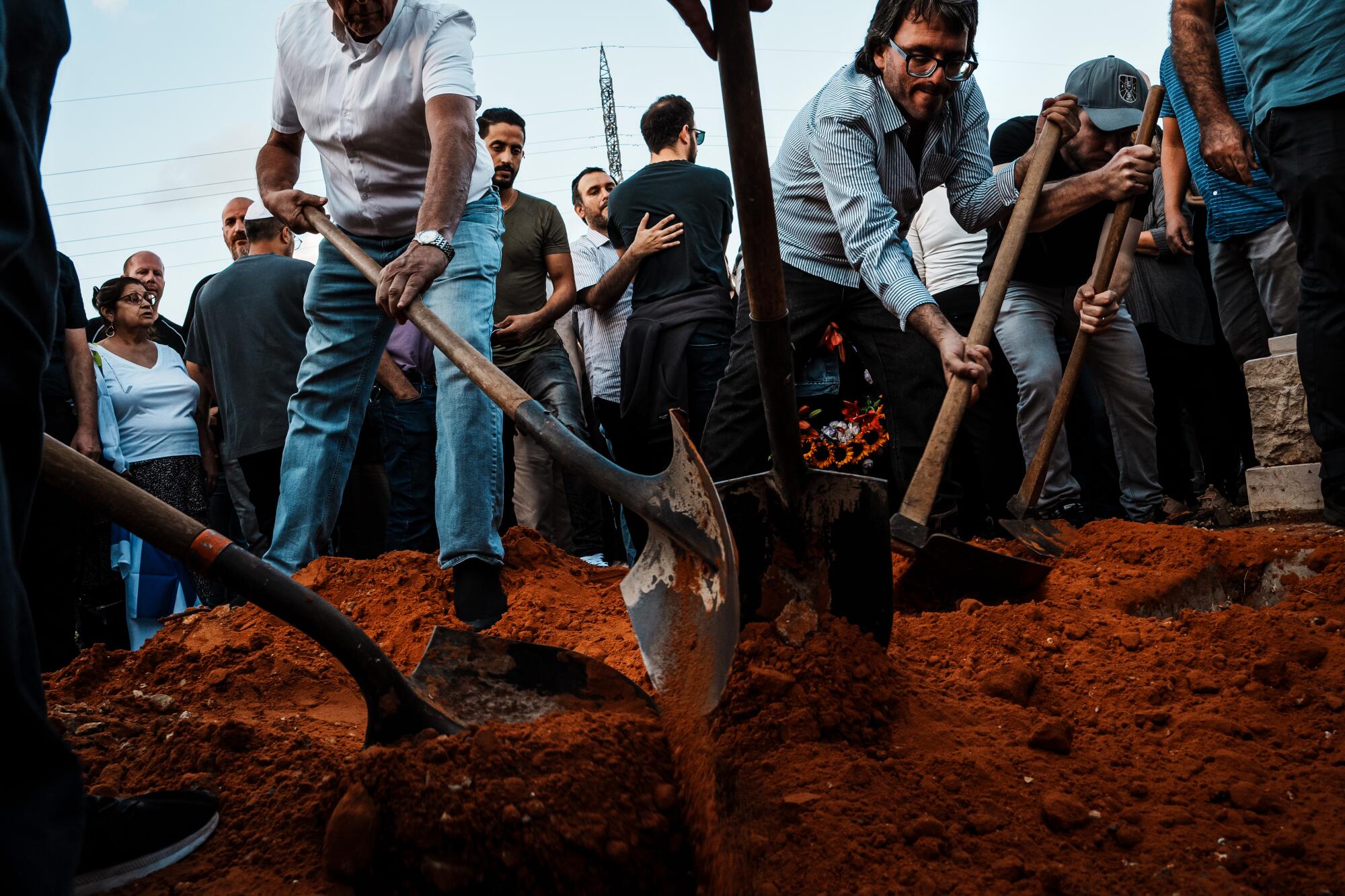
“After this first week, many of the families find that it becomes very lonely,” said a 42-year-old major in the reserves named Avraham, who had come to the cemetery to comfort the relatives of military members. “They begin to realize, to really understand, that their loved one will never return.”
As the new week began, a thick, enveloping mist seeped over the hillside cemetery after midnight, filling the air with tiny droplets and softening the glare of floodlights illuminating the rows of new graves. On plastic chairs, a huddle of young soldiers sat vigil — waiting for dawn to break, waiting for the next group of mourners to appear.
King and Bulos reported from Jerusalem and Yam from Kfar Azza. A special correspondent in Gaza contributed to this report; The Times is not using the reporter’s name for security reasons.
More to Read
Sign up for Essential California
The most important California stories and recommendations in your inbox every morning.
You may occasionally receive promotional content from the Los Angeles Times.
